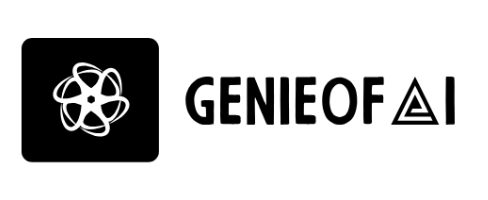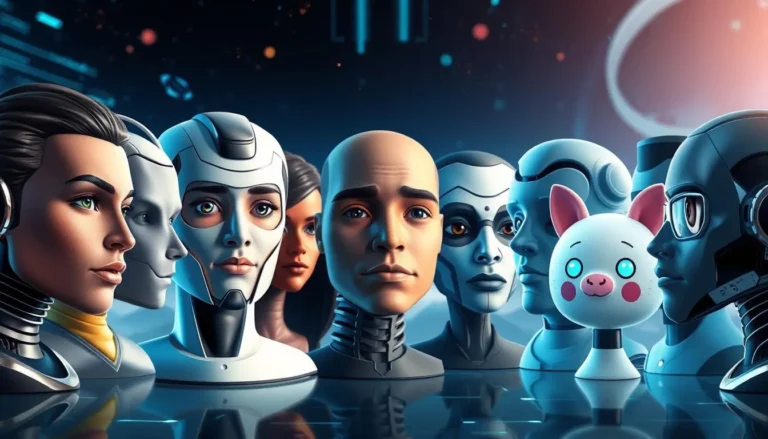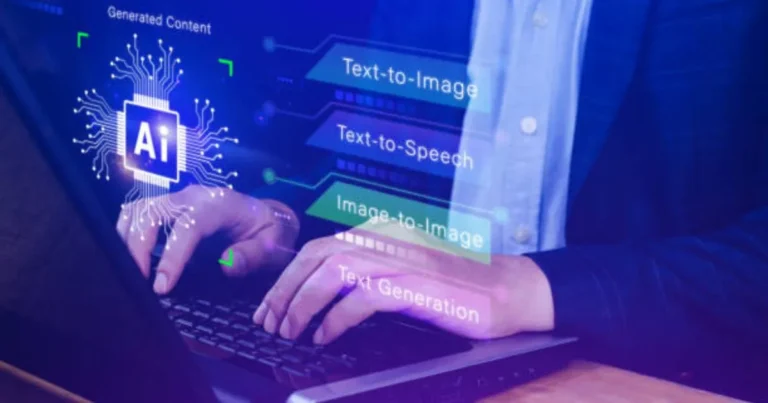What Is an AI Answer Generator and How Does It Work?
Table of Contents
Ever needed quick and accurate answers to your questions? An AI answer generator is here to help. It’s a tool that uses artificial intelligence to understand your query and give you a relevant response.
Think of it like having a personal assistant. This assistant can search through lots of data to find what you need. That’s what an AI-powered answer generator does. It looks at your input, gets the context, and gives you a response that fits your needs.
Exploring an AI response generator shows its wide range of uses. It’s changing how we get information in many fields. From customer service to education, it’s making a big impact.
Key Takeaways
- An AI answer generator uses artificial intelligence to provide accurate responses to user queries.
- It can process vast amounts of data to find relevant information.
- The technology has various applications across different industries.
- AI-powered answer generators are changing the way we interact with information.
- They offer a personalized experience by tailoring responses to user needs.
Understanding AI Answer Generators
Exploring artificial intelligence, you’ll find AI answer generators changing how we get information. These tools give accurate and relevant answers to many questions. They use advanced algorithms and large datasets.
Definition and Core Functionality
An AI answer generator is like a smart chatbot that answers questions like a human. It uses natural language processing (NLP) and machine learning to understand and answer. You can find some online for free, making them easy to use for many people.
Evolution of AI Text Generation Technology
The tech behind AI answer generators has grown a lot. It’s moved from simple rule-based systems to complex models. This change is thanks to better AI answering tech and more training data.
Popular AI Answer Generator Tools in 2023
In 2023, some top AI answer generator tools are:
- Tool 1: Known for its easy-to-use interface and high accuracy.
- Tool 2: Offers advanced features like customizable response styles.
- Tool 3: Has a free version with basic features, great for casual users.
These tools are used in many fields, like customer service and content creation. They show how versatile and useful AI answer generators can be.
The Technology Behind AI Answer Generators
The tech behind AI answer generators is complex. It combines natural language processing (NLP), machine learning, and neural networks. These work together to create responses that sound like they came from a human.
Natural Language Processing Fundamentals
NLP is key to AI answer generators. It lets computers understand and create human language. NLP mixes linguistics, computer science, and machine learning to handle big language datasets.
Tokenization and Semantic Analysis
Tokenization breaks text into words or tokens. Semantic analysis then figures out what these tokens mean. This is crucial for making accurate and relevant answers.
Machine Learning and Neural Networks
Machine learning and neural networks power AI answer generators. They learn from big datasets, getting better over time. Neural networks, especially deep learning models, are great at finding language patterns.
Transformer Models and GPT Architecture
Transformer models, like GPT, have changed NLP. They handle text data well, thanks to self-attention mechanisms. This design is key to top AI answer generators.
Training Data and Model Development
The quality of training data affects AI answer generators. Developers need big, diverse datasets. The model is then trained and fine-tuned to improve its responses.
Knowing these technologies helps us understand AI answer generators. This includes those using AI generator text tech.
How an AI Response Generator Creates Content
Ever wondered how an AI response generator makes content? It’s a detailed process. The AI takes in your input, creates content based on it, and then makes sure it’s just right.
Input Processing and Context Understanding
The first step is processing your input. The AI analyzes your text or query to get the context. It uses Natural Language Processing (NLP) to grasp language nuances. This is key for making content that’s both relevant and accurate.
Content Generation Process
After getting the context, the AI starts making content. It uses algorithms and machine learning models to guess the next words or characters. Thanks to huge datasets, it can spot patterns and create content that flows well and fits the context.
Token Prediction and Pattern Recognition
The core of making content is predicting tokens and recognizing patterns. The AI breaks down your input into tokens and guesses the next one based on learned patterns. This loop helps create a response that’s clear and meaningful.
Output Refinement and Quality Control
Once the content is made, the AI polishes it. It checks for grammar, syntax, and if it makes sense. Some AI tools also check if the content is engaging and relevant.
| Stage | Description | Key Features |
|---|---|---|
| Input Processing | Analyzing the input to understand the context | NLP, Contextual Understanding |
| Content Generation | Generating content based on the understood context | Machine Learning, Pattern Recognition |
| Output Refinement | Refining the generated content for quality and coherence | Grammar Checks, Syntax Checks, Coherence Analysis |
Practical Applications of AI Response Generators
AI answer generators are changing how we work in many fields. They make tasks easier and open up new ways to connect with customers. This leads to better productivity and more innovation.
Business and Marketing Implementation
In business and marketing, AI tools are making things more efficient. They help create top-notch content like product descriptions and social media posts. This keeps businesses looking good online all the time.
Customer Service and Content Creation
AI helps in customer service by answering questions fast. This makes customers happier. For creating content, AI gives ideas and drafts, speeding up the process.
Educational and Research Applications
In schools, AI makes learning materials like study guides and quizzes. Researchers use it to come up with ideas and analyze data. This makes research faster.
Personal and Creative Uses
People use AI for creative writing, like coming up with story ideas. It’s also used in games to create dialogue. This shows AI’s role in entertainment.
An expert once said:
“AI is not just a tool for automation; it’s a catalyst for creativity.”
This quote shows how versatile and powerful AI response generators are.
Benefits and Limitations of Using AI Text Generators
AI text generators have both good and bad sides. Knowing these is key to using them well. It’s important to see their good points and their downsides.
Key Advantages for Users
AI text generators can make you work faster and better. They help create drafts, summaries, and articles quickly. This lets you focus on more important tasks.
For example, an AI text generator online free is a cheap way to try these tools out.
- They bring new ideas and creativity
- Make making content faster
- Help those who aren’t good at writing
Current Limitations and Challenges
But, AI text generators also have big challenges. They might give wrong or biased info. You need to check and edit what they produce carefully.
| Limitation | Description | Impact |
|---|---|---|
| Accuracy | Potential for generating incorrect information | High |
| Bias | Risk of perpetuating biases present in training data | Medium |
| Originality | Limited ability to produce truly original content | Low |
Ethical Considerations and Best Practices
Using AI text generators right means knowing the ethics. This includes who gets credit for the work and being clear about AI use. It’s also important to make sure the content is right and fair.
By knowing the good and bad of AI text generators, you can use them well. This way, you get the most out of these new tools.
Conclusion
Exploring an ai response generator shows its huge potential. It can change how we deal with information. With ai answering, you can automate tasks, create top-notch content, and boost your work efficiency.
Think about how an ai response generator can help in different fields. It’s useful in business, marketing, education, and research. Knowing its strengths and limits can open up new chances for growth and creativity.
FAQ
What is an AI answer generator?
An AI answer generator is a tool that uses artificial intelligence. It generates human-like responses to questions. It uses technologies like Natural Language Processing (NLP) and machine learning.
How do AI answer generators work?
AI answer generators process the input they receive. They understand the context and generate content based on that. They then refine the output to make it coherent and relevant.
What are some popular AI answer generator tools available?
Popular tools include those based on transformer models like GPT. They are known for generating high-quality, human-like text based on input.
Can AI answer generators be used for customer service?
Yes, AI answer generators can be used for customer service. They automate responses to common inquiries. This frees up human agents to handle more complex issues.
Are there any limitations to using AI text generators?
Yes, there are limitations. They can generate inaccurate or irrelevant content if the input is not well understood. This can happen if the training data is biased or limited.
What are the ethical considerations when using AI answer generators?
Ethical considerations include ensuring the accuracy and fairness of the content. It’s important to avoid spreading misinformation. Transparency about AI-generated responses is also key.
How can AI answer generators be used in education?
AI answer generators can help in education. They can create educational content and assist with research. They can even help students by explaining complex topics.
What is the role of training data in AI answer generators?
The quality and quantity of training data are crucial. AI answer generators learn from the patterns and structures in the data. This affects their effectiveness.







